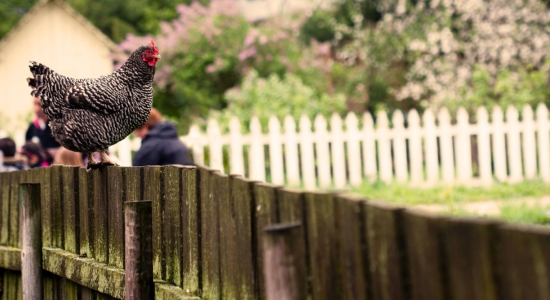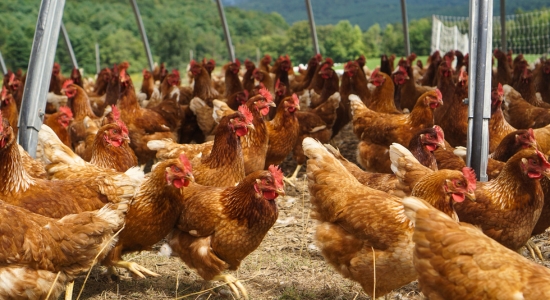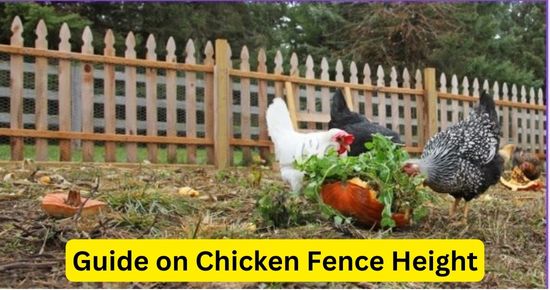The height of a chicken fence is important to keep your flock in the enclosure. A 4-foot fence is tall enough if they have to be kept there for a short time i.e. for night but not permanently. Most standard chicken fences are about 5 to 6 feet high. If you fence has an open top, flighty breeds, or want extra protection from escape or intruders, you might need a taller fence. The right height depends on your chicken breed and local predators.
- Average-weight chickens (2-3 kg) like to jump and perch high, so a 6-foot fence or higher is ideal.
- Even small bantam chickens can fly 4-5 feet. Heavier chickens are less active and don’t fly much, so a 4-5 foot fence is enough.
- If the fence isn’t covered at the top, it should be taller than these recommendations.
Is a 4-foot fence tall enough for chickens?
A 4-foot tall fence is enough for heavy chicken breeds like Wyandottes, Brahmas, and Buff Orpingtons. These breeds weigh 3-5 kg and, because of their heavier weight and fluffy bodies, they aren’t comfortable flying high and can only jump 2-3 feet. The heavier the breed, the less they can fly. However, if there are many predators in your area, the fence should be higher and covered.
Energetic breeds like bantams or average-weight egg-laying breeds such as Minorcas, RIRs, ISA Browns, Lohmann Browns, or Australorps can jump 6 feet or higher. Chickens naturally like to perch in high places, so a 6-foot or taller fence is ideal. If the top of the fence isn’t covered, make it taller than recommended to prevent escapes and keep predators out.
Clipping chicken wings reduces their ability to jump and makes them unable to fly. For example, if a breed can jump 6-7 feet, clipping their wings will limit them to 4-5 feet. This means you can use a 4-5 foot fence if their wings are clipped.
How tall should a chicken fence be?
When deciding on the height of a fence for chickens, several factors should be considered to ensure the safety and containment of the flock. Here are some key factors to take into account:
- Chicken breed & their nature
- Whether the top of the fence is covered or not
- Preying animals in your area:
- Area of the fence
Note: The chicken fence should also be high enough for you to easily perform the cleaning & related tasks.
1: Chicken breeds you have:
The main factor in deciding the height of your chicken fence is the type of breed. Different chicken breeds have varying flying abilities. Some breeds are known for being good flyers such as Bantams, & all average-weight egg-laying chicken breeds. While heavy chickens tend to be more grounded.
Research & observe your chickens to understand their behavior. Take note of any attempts to fly, roosting preferences, and overall activity levels.

Fence height for normal-weight chicken breeds:
Lighter to normal-weight chickens can fly higher than those with greater weight. The lightweight bantams & average egg-laying breeds weighing around 2-3 Kg(4-6 lb) can jump 6 feet fence.
For example:
The Leghorn breed weighs around 2-3 Kg & can fly up to 5-6 feet easily.
Rhode Island Red also weighs around 2.5-4 Kg & they can also fly up to 5-6 feet.
ISA Brown & Australorp also weighs around 2-3 kg, and they can easily escape a 6-foot fence.
Slightly heavier breeds such as Plymouth & other hybrid breeds can also fly up to 5 feet.
Hence, for average-weight chicken breeds fence should be at least 6 feet tall.
Out of the average-weight chickens, Light Sussex & the Plymouth rock are calm-natured and they are less likely to fly higher in order to escape the fence.
Fence height for heavy-weight chicken breeds:
Heavyweight chicken breeds like Orpingtons, Brahmas, and buffs can merely fly(jump) 3-4 feet. They are sluggish by nature & more likely to stay on the ground & are less prone to flying over fences. I’ve never seen my Buffs flying or crossing their 5 feet boundary. Hence for heavy breeds, chicken fence can be 4-5 feet higher.
What I’ve experienced:
I’ve raised various chicken breeds, including Bantams (white Bantams and Silver Sebrights), Australorps, Light Sussex, and Buffs. When I was in Pakistan, I also raised subcontinental hybrid breeds called Desi or Aseel chickens. In my experience, Australorps and hybrid Desi chickens were the best fliers and caused the most trouble, often jumping over a 7-foot boundary.
In warm weather, these chickens were naturally more energetic. Bantams could also cross a 5-foot fence. While white and black Bantams rarely escaped, the more energetic Sebrights often did. Buffs, being calm and heavy, couldn’t cross the boundary at all.
2: Understand your chicken’s behavior:
Different chicken breeds have varying flying abilities, so it’s important to research your breed to determine the right fence height. Here’s a guide based on chicken behavior:
Younger and more energetic chickens are likely to explore and try flying. Chickens naturally like to perch high, especially at night, for security, better ventilation, and to observe their surroundings.
Once chickens find a preferred perch, they stick to it. If your chickens like high perches, provide safe, elevated spots within the coop or run.
In the morning, hungry chickens might jump on the fence looking for food. If bored, they might try to escape. At dusk, they may jump fences if they roost high. To prevent this, get chickens used to their coop so they return on their own.
If your chickens prefer high roosts, it’s best to have a higher fence to prevent them from flying out.
3: Whether the top is covered or uncovered:
The height of the chicken fence also depends on whether the top of the fence will be covered or not. If you are providing larger space to chickens it might not be possible to cover the top. Hence there are greater chances that chickens will fly over the fence. Hence the fence should be at least 6-7 feet or higher.
If the top of the fence is covered, then the fence can be slightly less high. For example, a 6-foot-tall fence should be sufficient. While for the heavy breeds, a 5-foot fence can be effective.
4: Area of the chicken fence
There are 2 different things to keep in mind. The chickens can jump & fly which are two different. When chickens fly, taking a longer flight they can fly as high as 10 feet. However, from a smaller area, they can’t directly fly over the fence. So they jump, fly & climb a little to reach approximately 6 feet higher fences.

For small area fences the height should be slightly higher than general as the chickens may get bored from the space & try to escape.
5: Preying animals in your area:
Determining the appropriate height for a chicken fence highly depends on the types of predators in your area that can climb the fence. As I know, domestic or stray cats, raccoons, possums, bobcats, fishers, and minks are proficient climbers who can breach the fence to snatch your chickens.
Assess the types of predators in your area. A taller fence not only prevents chickens from escaping but also helps deter ground-based predators. Make sure the fence is predator-proof by extending it into the ground or using aprons to prevent digging.
Consider using covered enclosures or chicken runs if aerial predators are a concern. This provides an additional layer of protection against predators like hawks or kites. However, flying predators are pretty smart; they tend to avoid attacking in tight spaces where they might get stuck.
Conclusion:
By considering factors like breed type, and behavior, & the type of predators in your area you can determine the appropriate height for your chicken fence to balance containment, safety, and the natural behavior of your flock. For light to medium-weight chicken breeds the fence should be at least 6 feet higher. For heavy chickens, fence should be 4-5 feet tall. Regularly assess the condition of the fence and make adjustments as needed based on the development and behavior of your chickens.
If you still need assistance ask us in the comments

